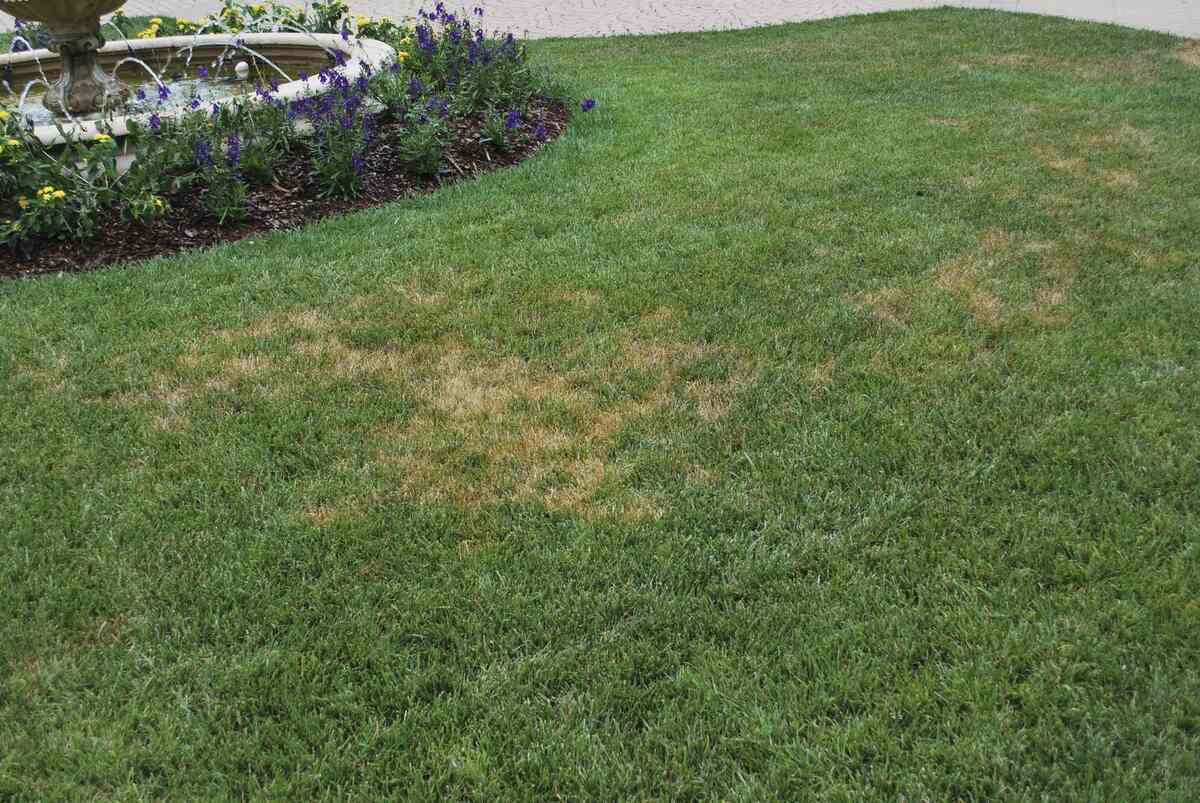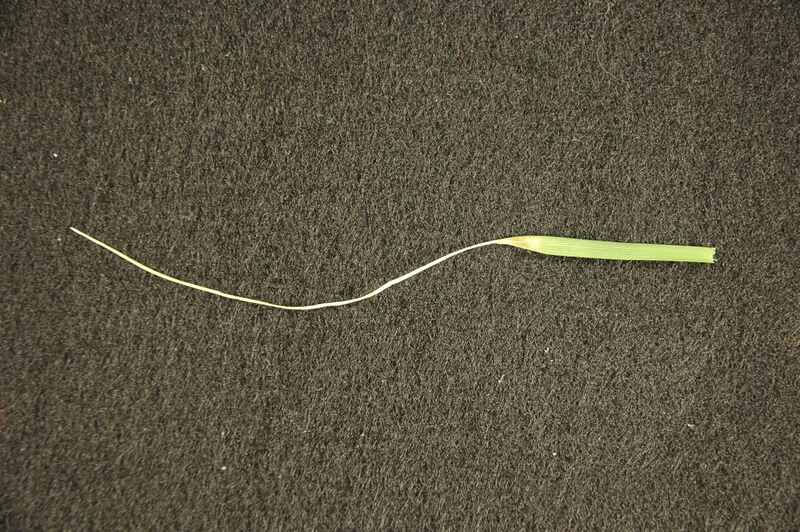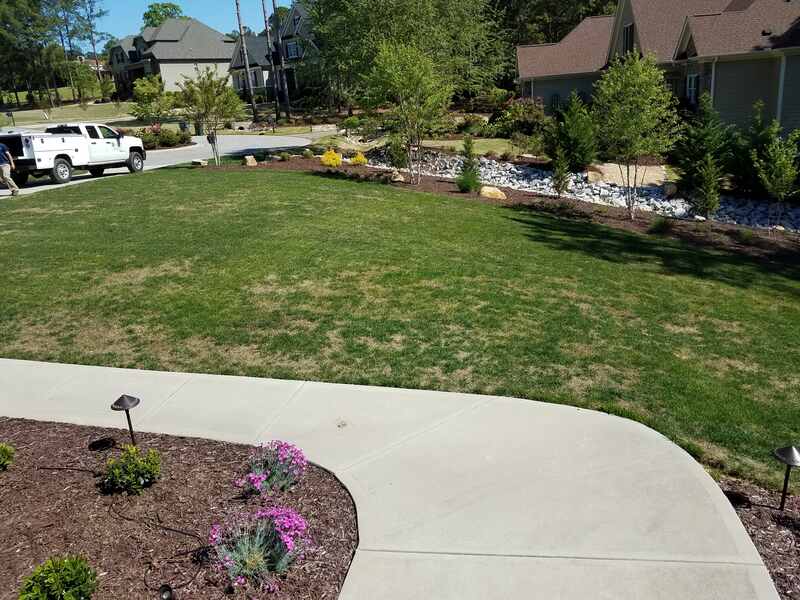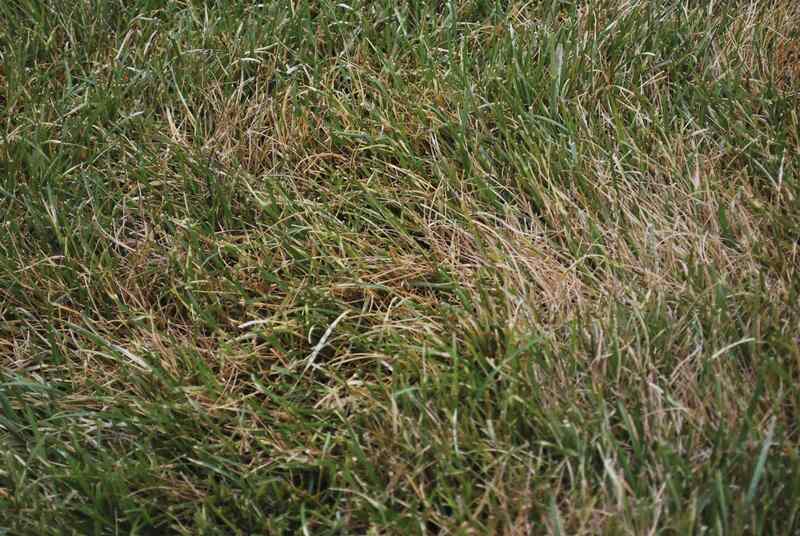
Seeing Ascochyta leaf blight on your grass can fill your heart with sharp panic. Though a minor and harmless fungus, it creates daunting dry patches of grass overnight. The damage is cosmetic and goes away in 2 to 3 weeks, but it can be easily confused with more serious diseases. Here’s how to identify, control, and prevent Ascochyta leaf blight on turfgrass to keep the turf green and healthy and your heart at ease.
How to Identify Ascochyta Leaf Blight in Your Lawn

It’s so easy to confuse leaf blight in lawns with drought stress that you might miss it. Read this section to ensure you catch any leaf blight infection in your lawn in a timely manner. We talk about:
- Signs and Symptoms of Ascochyta Leaf Blight
- When is Your Lawn Exposed to Leaf Blight Disease?
- How to Test for Ascochyta Leaf Blight
- Lawn Diseases You Can Confuse With Leaf Blight
Signs and Symptoms of Ascochyta Leaf Blight
With off-color patches spreading across the lawn, leaf blight symptoms look similar to the common drought stress at first sight. But the disease also has a few tell-tales to help you identify it. This is how it looks if active in your lawn:
- Sudden straw-colored patches: Leaf blight makes large straw-colored patches where grass appears dead. Damaged areas have an irregular shape and show up suddenly. You can wake up with them one morning on a lawn that was perfectly green last night.
- Stripe-like patterns: If you’ve caught some fungi on your mower’s wheels, instead of developing patches, the lawn will look like a sports field waiting for action. In this case, straw-colored parallel stripes follow your mowing pattern across the turf.
- Green blades interspersed with dry ones: The patches may look completely dry from your doorstep, but if you get closer, you’ll see green blades of grass between the straw-colored ones.
- Leaves are partly green, partly dry: Damaged blades have a dry, straw-colored tip, often collapsed in half through the entire vertical plane, taking up to ⅓ of the blade’s length. In some grass, you’ll see a dry segment in the middle of the blade, with its top and bottom still green. Or, you might see a purple discoloration spread across the green blade.
- No crown or root damage: Ascochyta leaf blight doesn’t attack the crown and roots of your grass. If you pull out some grass and notice that the roots look damaged or rotted, that’s a sign that you’re probably dealing with something other than leaf blight.
- Microscopic fungal signs: This fungus produces tiny yellow to brown flask-shaped fungal fruiting bodies called pycnidia that are visible with the help of a hand lens or a microscope. They harbor in the leaf tissue, making it look peppered.
When Is Your Lawn Exposed to Leaf Blight Disease?
Outbreaks typically occur in late spring and summer when environmental conditions change from cool and wet to hot and dry.
If the grass is vulnerable, it typically takes about 10 days for the disease to take hold after a sudden increase in temperature and change a green lawn into a sickly-looking one. The worst Ascochyta outbreaks happen from June to August.
Ascochyta fungus survives during winter as spores in thatch and grass clippings protected in its pycnidia, a structure resistant to extreme temperatures and drought. That means the disease can return next summer if you don’t kill it off completely.
How to Test for Ascochyta Leaf Blight
Walk to a damaged area in your lawn and look for blades that show specific signs of Ascochyta:
- A dry segment in the middle of the blade, between a green top and a green bottom.
- Blades with the top ⅓ dry, tan-colored, and collapsed in half vertically.
To be 100% sure it’s Ascochyta, collect a sample of damaged grass and send it for testing at a plant pathology lab in your area. The disease symptoms will probably be gone by the time you receive the test results. But, it’s important to know if you have the fungus to take preventive measures for next year.
Lawn Diseases You Can Confuse With Leaf Blight
Asochyta leaf blight symptoms resemble drought stress but can also be confused with signs of infection in other common lawn diseases like dollar spot and brown patch.
Dollar Spot
Also a cool-season grass disease that activates during summer, dollar spot begins by forming small gold dollar-sized yellow or straw-colored to light brown circular spots. These spots can merge into larger, irregularly shaped patches, similar to the patches caused by leaf blight.
The difference is that dollar spot gives individual leaves lesions that are tan-colored with reddish-brown margins, while the blade is damaged uniformly with leaf blight. Dollar spot also produces a whitish mycelium visible in the morning on soil and grass.
Brown Patch
Turfgrass affected by brown patch has circular and oblong lesions on its blades with a straw-colored center and a brownish edge. In time, the lesions grow to cover the entire surface of the grass blades. Patches are circular, with sunken centers that often recover, going green and creating the signature frog-eye or donut appearance. The brown patch disease also spreads whitish fungal threads across the soil and grass, which are absent in cases of leaf blight.
How to Prevent and Treat Leaf Blight Disease

Fungicides are not necessary to treat Ascochyta blight, and preventive applications are almost impossible to get right since the disease’s outbreaks are hard to predict. The best way to control leaf blight is through cultural practices, which means taking care of your lawn in specific ways. Here are the most important practices to apply.
Keep Lawn Mower Blades Sharp
Check the lawn mower blades regularly, especially when the mower doesn’t cut as cleanly as it should. Sharp blades make clean cuts that heal faster and reduce fungi’s time to infect the grass. Here’s a practical guide on how to sharpen mower blades correctly.
Avoid Mowing Wet Grass
Damp grass is slick and tough to slice. It clumps together, making it hard for the mower blades to get a clean cut. Mowing in the mornings with heavy dew or just after rain or irrigation exposes your lawn to more wounds – entry points for the Ascochyta fungi.
Mow Infected Areas Last
Always leave infected areas last to mow and clean the mower thoroughly after use to avoid spreading the fungi. Also, carefully collect grass clippings and don’t let them spread to healthy parts of the lawn. Ascochyta dwells in foliage and travels easily with lawn care tools.
Limit Nitrogen Fertilizer Applications in the Spring
Don’t apply too much nitrogen fertilizer in the spring. It forces the grass to grow taller and faster and you to mow it more often. More mowing = more grass wounds. More grass wounds = more exposure to Ascochyta infection.
Postpone fertilizer application until the turf greens up and reaches its normal growing rate for the season. To promote root development, you can amend the spring soil by topdressing with compost or using a balanced natural fertilizer that contains equal nitrogen and potassium.
Periodically Check Sprinkler Heads
You can get a “beautiful” Ascochyta infection if some of your sprinkler heads are clogged and areas in your lawn suffer drought stress as a result. To avoid it, conduct a sprinkler system audit in early spring before turf green-up and anytime there’s something wrong with how your lawn receives water. Adjust the sprinkler nozzles, clean clogged pipes or sprayers, and repair or replace broken sprinkler heads to ensure your grass is irrigated properly.
Avoid Excessive Irrigation
Too much moisture in your lawn supports fungal disease development. Follow the correct lawn irrigation practices for your grass type and water deeply and less frequently to promote robust roots instead of fungi. Consider installing a timer and automating the system if that makes it easier for you to keep a correct watering schedule.
Aerate the Lawn Yearly
A good way to manage water flow in your lawn is to core aerate the soil once or twice a year to alleviate soil compaction. Compaction is more severe in heavy clay soils, and aeration might be required more than once a year if you have this type of soil.
You must also aerate more often if the turf takes heavy foot traffic. Core aeration loosens the soil, allowing water to drain correctly and preventing moisture from staying near the soil surface.
For more information, check out When and How Often Should You Aerate Your Lawn?
Apply Humate Soil Conditioner on Clay Soil
Think of a humate soil conditioner as a superconcentrated compost, rich in organic matter, humic acid, and fulvic acid. It’s not a classic fertilizer because it doesn’t focus on the N-P-K nutrient core.
Instead, it offers all the right stuff (micronutrients, organic matter, and acids) needed to help develop beneficial microorganisms that, in turn, loosen the soil structure and improve water and nutrient absorption and drainage.
If your lawn has heavy clay soil and compaction is a permanent issue despite frequent aeration, experts say yearly treatments with a humate soil conditioner can help. Here are a few popular products for gardens and lawns:
How to Repair the Lawn After Leaf Blight

The damage to your lawn is only cosmetic and temporary. Turf typically recovers without intervention in about 2 to 3 weeks since the disease affects only the grass blades and not the crown or roots. You can help by:
- Mowing and raking the affected patches to remove dry, straw-colored tips and expose more of the lower blades, which are green.
- Spray some grass paint to cover the straw-colored patches until they grow enough to mow them completely.
Remember, during summer, cool-season grasses slow their growth. You can apply some slow-release nitrogen to help their development, but not too much. If you force them to grow faster, they’ll become vulnerable to heat and drought and risk other, more severe fungal diseases.
What Causes Ascochyta Leaf Blight?
There are about 80 types of fungi in the Ascochyta family that cause leaf blight disease in turfgrass. This pathogen is still a mystery regarding the environmental conditions that trigger it. Disease activation has something to do with sudden increases in temperature after a high humidity period. Ascochyta outbreaks are favored by faulty lawn care practices such as:
- Faulty sprinkler systems: Clogged or poorly positioned sprinkler heads that fail to cover the lawn uniformly lead to overly moist and overly dry areas exposed to disease.
- Frequent mowing: This fungus enters the leaf through the mowing cut at the top of the grass blades. If you have it in your lawn, each mowing session is another chance of spreading it and infecting healthy grass.
- Dull lawn mower blades: Dull mowing blades tear the leaf instead of making a clean cut. The wound heals slower, allowing Ascochyta more time to infest the tissue.
- Overfertilization: Turfgrass fed with too much nitrogen grows faster and taller, requiring more frequent mowing. The blade tissue is also more tender and easier to penetrate.
- Compacted soil: A high soil compaction prevents proper water absorption, keeping the moisture at the surface and in the thatch, where fungi thrive and shelter. It also prevents roots from properly developing, making the grass plants less able to protect themselves against infections.
- Thick thatch: Ascochyta is a foliar fungus that shelters in thatch, grass clippings, and dead leaves. A thick thatch layer makes the fungus’s survival and spread easier. It also suffocates grass stems and leaves, preventing healthy growth.
- Overwatering: Irrigating the lawn often and shallowly gives Ascochyta the moisture it needs to thrive and promotes shallow root growth, making plants more vulnerable to drought and disease.
Susceptible Turfgrasses

Ascochyta leaf blight is a cool-season grass fungal disease. If you’re growing Kentucky bluegrass, you are the most likely to see leaf blight in your lawn, but perennial ryegrass and tall fescue lawns are also commonly affected.
Some lawn experts say Ascochyta blight appears more often in lawns with shallow roots no more than 2 inches deep, preventing the grass from adapting to sudden rises in heat. Normal, healthy grass with roots 6 to 12 inches deep is less vulnerable to this fungus.
FAQ About Ascochyta Leaf Blight Disease
How Do I Treat Ascochyta on My Lawn?
To treat Ascochyta in your turf and prevent it from returning, follow proper lawn care practices such as:
- Detach and aerate to improve water absorption, drainage, and proper grass plant development.
- Audit the sprinkler system periodically to ensure uniform irrigation across the lawn.
- Follow a proper fertilization program.
- Mow less often during infestation and let the grass grow taller during summer. Don’t mow wet grass, and keep the lawn mower blades sharp.
- Water deeply and less often.
What Causes Lawn Blight?
Lawn leaf blight is caused by fungi in the Ascochyta family during late spring and summer when high temperatures and drought stress the turf after high humidity and cooler days in spring.
What Does Blight Look Like on Grass?
Lawn blight looks very similar to drought stress, making irregular patches of blighted, straw-like grass that appear dry and dead from a distance.
What’s the Best Fungicide for Leaf Blight?
Leaf blight outbreaks look scary, but the disease is harmless and doesn’t require fungicide. Damage is cosmetic and goes away in 2 to 3 weeks.
When to Call a Lawn Care Professional
The first time you notice the symptoms of a lawn disease is the best moment to call a lawn care pro for help diagnosing and treating the issuel. This way, you can ensure it is leaf blight and not something worse, and you can set up proper lawn care practices to help recovery and prevent re-infestation.
LawnStarter can connect you with your area’s best lawn treatment experts in a jiffy. Just enter your address into our online form, and we’ll help you get a free quote without ever leaving your computer.
Main Photo Credit: NC State Cooperative Extension